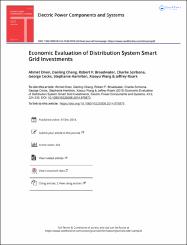| dc.contributor.author | Önen, Ahmet | |
| dc.contributor.author | Cheng, Danling | |
| dc.contributor.author | Broadwater, Robert P. | |
| dc.contributor.author | Scirbona, Charlie | |
| dc.contributor.author | Cocks, George | |
| dc.contributor.author | Hamilton, Stephanie | |
| dc.contributor.author | Wang, Xiaoyu | |
| dc.contributor.author | Roark, Jeffrey | |
| dc.date.accessioned | 2022-08-02T12:55:09Z | |
| dc.date.available | 2022-08-02T12:55:09Z | |
| dc.date.issued | 2015 | en_US |
| dc.identifier.issn | 15325008 | |
| dc.identifier.uri | https://doi.org/10.1080/15325008.2014.975873 | |
| dc.identifier.uri | https://hdl.handle.net/20.500.12573/1339 | |
| dc.description.abstract | This article investigates the economic benefits of smart grid automation investments. A system consisting of 7 substations and 14 feeders is used in the evaluation. Here benefits that can be quantified in terms of dollar savings are considered, termed "hard dollar" benefits. Smart grid investment evaluations to be considered include investments in improved efficiency, more cost effective use of existing system capacity with automated switches, and coordinated control of capacitor banks and voltage regulators. These smart grid evaluations are sequentially ordered, resulting in a series of incremental hard dollar benefits. Hard dollar benefits come from improved efficiency, delaying large capital equipment investments, shortened storm restoration times, and reduced customer energy use. Analyses used in the evaluation involve hourly power flow analysis over multiple years and Monte Carlo simulations of switching operations during storms using a reconfiguration for a restoration algorithm. The economic analysis uses the time-varying value of the locational marginal price. Algorithms used include reconfiguration for restoration involving either manual or automated switches and coordinated control involving two modes of control. Field validations of phase balancing and capacitor design results are presented. The evaluation shows that investments in automation can improve performance while simultaneously lowering costs. | en_US |
| dc.language.iso | eng | en_US |
| dc.publisher | Taylor and Francis Inc. | en_US |
| dc.relation.isversionof | 10.1080/15325008.2014.975873 | en_US |
| dc.rights | info:eu-repo/semantics/openAccess | en_US |
| dc.subject | Capacitor design | en_US |
| dc.subject | Coordinated control | en_US |
| dc.subject | Monte carlo simulation | en_US |
| dc.subject | Phase balancing | en_US |
| dc.subject | Smart grid investments | en_US |
| dc.title | Economic evaluation of distribution system smart grid investments | en_US |
| dc.type | article | en_US |
| dc.contributor.department | AGÜ, Mühendislik Fakültesi, Elektrik - Elektronik Mühendisliği Bölümü | en_US |
| dc.contributor.authorID | 0000-0001-7086-5112 | en_US |
| dc.contributor.institutionauthor | Önen, Ahmet | |
| dc.contributor.institutionauthor | Broadwater, Robert P. | |
| dc.identifier.volume | 45 | en_US |
| dc.identifier.issue | 2 | en_US |
| dc.identifier.startpage | 224 | en_US |
| dc.identifier.endpage | 233 | en_US |
| dc.relation.journal | Electric Power Components and Systems | en_US |
| dc.relation.publicationcategory | Makale - Uluslararası Hakemli Dergi - Kurum Öğretim Elemanı | en_US |


















